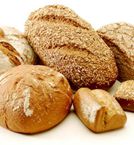Things to Bear in Mind When Preparing Food
The following are some general guidelines for food preparation and safer swallowing. Please remember that dysphagic patients have individual requirements, so all of these guidelines may not apply to every patient.
Enrichment
A dysphagic patient often suffers weight loss and other nutritional problems, so it is almost essential to enrich food in some way. A dietician may be able to help with this if you are referred to one. Almost anything you add to any food will effectively augment it, although enrichment items tend to be protein based. However, sometimes a dysphagic patient may lack other nutrients in the diet, so I have included some below along with the obvious ones. I have annotated the main enrichment tips with a border around them as I have done with this paragraph.
Viscosity or "thickness"
Initially, Alex frequently choked when drinking coffee or eating very sloppy blended food. We thought that if a person cannot swallow easily, food should be as watery as possible so that it slides down the oesophagus and does not get stuck. Not always so. Thicker (more viscous) foods are generally easier and safer to swallow than thinner foods as the risk of fluids going down "the wrong way" into the lungs is reduced.
Imagine a bucket of water under a dripping tap. Each drop causes splashes, often over the side of the bucket. Now, if you substitute the water for thick custard, each custard drop will not splash as high as a water one and so it is unlikely the custard drop will go over the side of the bucket. In a dysphagic patient where swallowing is slow or obstructed, a water splash could go up and over into the trachea causing choking if the epiglottis is not over the trachea entrance. This is less likely with a thicker fluid.

However, I am reliably informed that for people with COPD, Parkinson's, MND and a number of other illnesses, thicker substances can coat the pharynx (back of the throat) and cause post-swallow aspiration from a build-up of pharyngeal residue. This occurs particularly when a person lacks the muscular strength to clear the bolus through the second part of the pharynx. Therefore, in these cases, thicker food / fluids can, at times, be more unsafe to swallow than thin substances. So know your patient!
Even though water, tea and coffee etc. may be too "thin", it is important for a patient not to dehydrate. Water can be introduced into a diet in other ways – soups, sauces, jellies, milkshakes, smoothies (good for your 5 a day too) and fruit cocktails. Also remember that food itself, unless totally dehydrated, contains some water too. However, depending on the patient, sometimes jelly, sorbets or ice cream may not be suitable as these melt in the mouth and become too "thin".
Consistency or texture
You will have to decide what level of consistency (texture) your patient needs so as not to choke.

This can be:
- chopped - food particles ½ inch (12mm) or about the size of sugar cubes
- ground – food particles ¼ inch (6mm) or about the size of grains of rice
- minced - food particles 1/8 inch (3mm) or about the size of sesame seeds
- puréed - smooth mashed potato consistency for severely dysphagic patients




Whatever level is best for your patient, the food needs to be soft and moist, especially if saliva production is difficult. Also the texture should be uniform throughout the portion. This is particularly important for the patient on puréed food. The liquid MUST be fully mixed in with the solid. Therefore, before serving a meal containing a sauce or gravy etc. you must ensure there is no loose fluid. Puréed food can settle, separating solids and liquids, so make sure you shake them up or stir thoroughly just before serving.
Seasoning and taste
Alex found his taste had changed – everything seemed to taste metallic or some other taste. We tried to compensate for this by adding stronger flavours such as spices.
Puréed or blended foods lose their taste (see Blending section below). A dish you cook may be seasoned perfectly, but, after blending, it will taste different. Therefore, before serving a puréed meal, please check the seasoning. I often had to re-season, again and again. The main point is to prevent food from being bland and boring. If you need to add water for the blending process, often more flavourful or spicy ingredients might be needed during cooking so that the food does not taste too diluted once blended.
Blending or puréeing
Blending and puréeing are slightly different food preparation processes, but, for the purpose of this guide, I will treat them the same.

You cannot blend dry food - it has to be moist e.g. stewed fruit or it must contain a liquid e.g. casserole or soup. If you need to blend a dry food, you will have to add a "lubricant" such as water, milk, olive oil, juice or sauce, but do not forget to check seasoning afterwards and re-thicken if necessary.
Besides being easier to swallow, blended food can help with portion size and frequency of meals (see section on this below) as blending gets rid of most of the spaces between food particles, e.g. I found an average portion of spaghetti Bolognese would purée down to a few tablespoonfuls. As blending food already starts off the digestion process by breaking it down, a patient can absorb much more nutrition while spending less energy on digestion. Therefore, a patient is often more satisfied with much less food than they might have been with unblended food. They are often not hungry for many hours after eating blended food or even a blended soup!

There is one problem with blending though. When we blend foods, oxygen mixes with the food particles and each particle of food becomes exposed to oxygen. This is called oxidation. Oxidation contributes to destroying the nutritional value of food, its colour, smell and taste. I am sure you have all seen an apple go brown if you bite and leave it. It tastes different too if you then bite into the brown part. That is why food manufacturers often add antioxidants to food or pasteurise (heat) food to stop it deteriorating. You may have noticed how cooked apple does not discolour, but tastes different to raw apple. Therefore, it is best to blend food for the minimum time possible, especially when using high speed, so as to keep as much of its nutritional value as possible. Also serve these foods as soon as you can after blending.
Soup
Blending a soup rather than leaving "bits" still in it (even if they are soft and manageable) is far more beneficial to a dysphagic patient as it is more "filling" and helps with portion size. I would recommend that you always blend your soup, any soup. Chopping vegetables and herbs then does not have to be so neat, so it saves you time in the kitchen!
Colour and sauces
I found that once Alex had resigned himself to the fact that he had to have puréed food, he did not mind a pile of "khaki coloured baby food" as he called it on his plate. He was more interested in a small portion of something really tasty rather than concern himself with what it looked like.
In hospital, dysphagic food seemed to come in three dollops on the plate which resulted in guessing games. A cream coloured dollop (maybe puréed potato?), a beige coloured dollop (maybe puréed chicken?) and a green or orange coloured dollop (maybe puréed peas or carrots?). Sometimes, we were given a clue e.g. the orange coloured purée had been put into a carrot-shaped mould! Either way, every dollop seemed to have no taste whatsoever (presumably due to the blending process described above), so the pepper sachet came in handy to give at least a little bit of flavour.

However, if your patient prefers distinct colours on a plate (and you have time for separate blending and the extra washing up!) then please ensure each different food on the plate has the same consistency and viscosity. You then have to decide as to which dollop you are going to add the tasty sauce or gravy prior to blending, but without altering the colour. I am afraid I never discovered a way of not altering the colour of, say chicken, when adding a sauce or gravy, so I cannot pass on any advice on this.
Standby food and supplements
When preparing meals, have cupboard standbys in reserve. I found that what went down one day, may not another day. As disheartening as it might be to see your hard work go to waste, try not to get cross about it and just go to the kitchen cupboard and make up a portion of Complan or heat up a jar of baby food (which is not as bland as you think, but may need a bit of salt or other seasoning). This is a lot less stressful for you and the dysphagic patient who is often very embarrassed by not being able to swallow a meal you have painstakingly prepared.

Although I don’t like to advertise, a range of special food by Nutricia is very useful to have as a supplement or standby. The range includes Fortisip, Fortijuce, Forticreme and others and they are nutritionally complete, small portions suitable for dysphagic patients. You can get them on prescription if your GP is willing to prescribe them (or a non-proprietary equivalent). Some flavours are available from the pharmacy counter in chemists or you can order them in. They are not cheap, but sometimes it is a small price to pay to ensure the dysphagic patient does not become malnourished.
Meat and offal
Alex and I loved BBQ’s and grilled meat, but, once he started to suffer with dysphagia, we had to re-think cooking methods. He found beef and lamb (red meat) difficult to swallow due to the structure of the muscle fibres, even when blended. Chicken, other poultry and very soft pork muscle fibres seemed easier to swallow so we tended to use these. He found liver was also easier to swallow due to its texture and structure and provided a good source of iron too. Kidneys were also frequently on the menu for ease of swallowing. We did try tofu several times, but Alex did not enjoy it. You might like to experiment with it though.
Bread
Alex found bread difficult to swallow, even wholemeal, as the food bolus became a rather dry lump which got stuck in his oesophagus. Until he went on a puréed diet though, we did find that tortilla wraps and certain crackers were much easier to swallow than bread as the proportion of moist filling to starch was much increased.

Potato
When Alex was able to eat mashed potato, ordinary mash was too "dry", but he could manage very creamy mash or mash mixed with gravy or grated cheddar cheese or an egg – all easy ways of enriching mashed potato.
A tasty variant was to add 1-2 (and I mean 1-2) drops of truffle oil to mash.
Salad
Alex and I loved salads (lettuce, baby leaves, rocket, raw spinach, Chinese leaf, cucumber, tomato, red and yellow peppers, carrot, radishes, kohl rabi, spring onions, baby corn, sugar-snap peas etc which we often grew in the garden) tossed in home-made dressings or left plain with just a drizzle of balsamic vinegar.

When Alex first started to experience swallowing difficulties, the worst "culprits" were the thin salad leaves which always seemed to get stuck to the wall of his oesophagus. We substituted these for the white rib (fleshy part) of Chinese leaf. However, when his symptoms worsened, we still managed to incorporate salad into his diet in purée form (see Recipe section below).